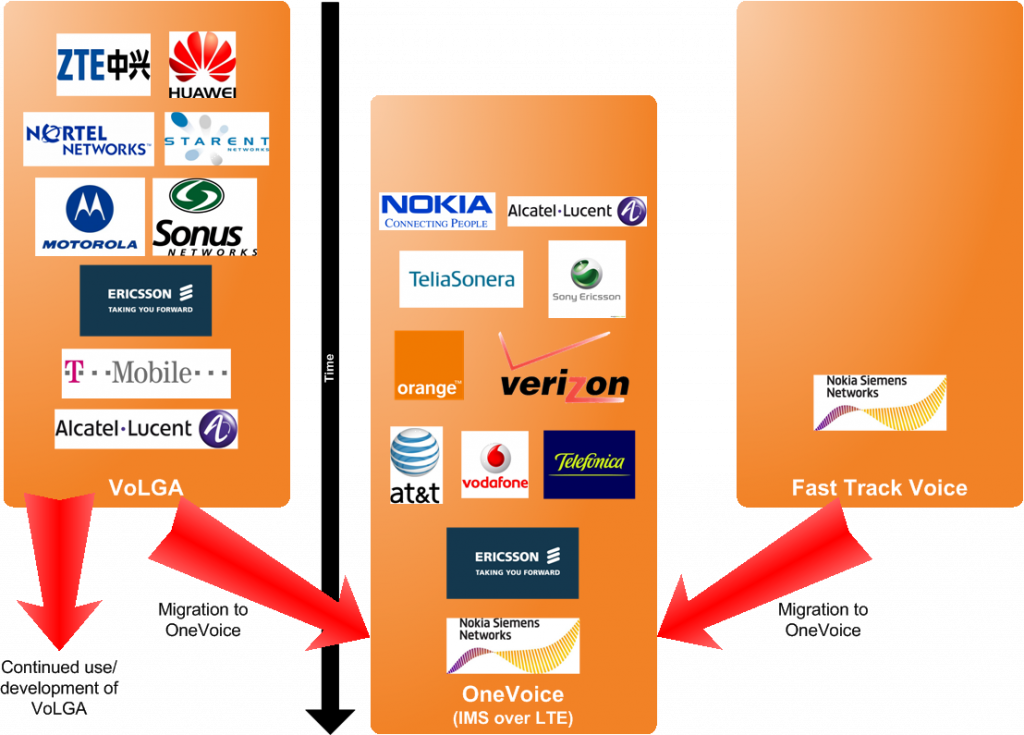Originally posted on 25Nov09 to IBM Developerworks where it got 7,721 Views
I noticed this article today at FierceWireless today:
Verizon, AT&T, others rally on IMS approach to voice over LTE
November 4, 2009 — 11:10am ET | By Phil Goldstein
Read more: Verizon, AT&T, others rally on IMS approach to voice over LTE – fiercewireless.com
Verizon Wireless, AT&T and several major international carriers and vendors threw their support behind an IMS-based approach to delivering voice and SMS services over LTE networks. The level of operator support–the approach also is supported by Orange, Telefonica, TeliaSonera and Vodafone–sits in sharp contrast to another approach, called Voice over LTE via Generic Access, or VoLGA, which is supported by T-Mobile International.
Vendors including Alcatel-Lucent, Ericsson, Nokia Siemens Networks, Nokia, Samsung Electronics and Sony Ericsson also voiced their support for the initiative, dubbed One Voice. The companies said they concluded that an IMS-based approach “is the most applicable approach to meeting the consumers’ expectations for service quality, reliability and availability when moving from existing circuit-switched telephony services to IP-based LTE services. This approach will also open the path to service convergence, as IMS is able to simultaneously serve broadband wireline and LTE wireless networks.”
The companies said that the purpose of the initiative is to create the largest LTE ecosystem possible, and to avoid fragmentation of technical solutions.
Interestingly, both Alcatel-Lucent and Ericsson also support the VoLGA approach, and Nokia Siemens has supported its own solution, called Fast Track Voice, which proposes having mobile switching center servers handle VoIP traffic over LTE networks. VoLGA proponents argue that their approach should be used as an interim solution. All three vendors said they do not see a conflict in supporting the different approaches.
continues…
For more: See this release – SMS over LTE
See also this related article on UnStrung
Is it just me or when you read “VoLGA” do you think “Vulgar” – I think the ALu acronym police need to get out from behind their desks and make an arrest for that one!
I’ve drawn up a representation of the situation as I see it. NSN going it alone with Fast Track Voice, almost everyone else supporting VoLGA and planning to move to OneVoice.

The thing that I find really interesting is the inference by ALu that they will continue to stand by VoLGA as well as support it as an interim step to OneVoice while NSN seem to be saying that Fast Track Voice is only an interim step on the path to OneVoice. It’s also interesting to note that the VoLGA consortium seems to be mainly Network Equipment Providers (NEPS) while OneVoice is both NEPs and Telcos…. I suppose the most appropriate message is “watch this space”…
PS. On rereading this post, I imaging some of you are going ‘Huh?’ I apologise for the Telco jargon. Let me take a moment to try and explain some of the terms that appear in this post.
- IMS – IP Multimedia Subsystem (not IBM’s mainframe database that helped put man on the moon). This is a specification controlled by 3GPP (a Telco standards body) to describe a next generation IP based telephony environment. Most telcos today still run a legacy switched environment based on very specialised protocols such as SS7 and Sigtran. These protocols are not IP based and as such require very specialised (read expensive) skills to work with them. The other thing is that they are not really standardised – each NEP has their own version of the SS7 protocols. IMS promises to bring much cheaper skills and shorter development cycles to the Telcos core platform – something they have not had before. IBM has a number of products that are targeted at telco’s IMS infrastructure (WebSphere IMS Connector, WebSphere Presence Server and WebSphere XML Document Management Server)
- LTE – Long Term Evolution is seen by most NEPS as the next logical evolution step for carriers with GSM networks. That evolutionaty path goes something like this: GSM->GPRS->EDGE->UMTS->HSDP->LTE. LTE promises to deliver high bandwidth mobile connections. The main rival to LTE is WiMax which you may have heard of before.
- ALu – Alcatel Lucent (a very common abbreviation for the joint company)
28Nov19
This post hasn’t really aged well. I’ve reposted it because it shows a historical perspective of the direction beck in 2009. These days, the acronym of choice is VOLTE – or Voice Over LTE. VOLTE has received a lot of traction in the past ten years with Apple, Google and others building support for VOLTE into their phones for a number of years now.
